| 系统 | ip |
|---|---|
| centos7 | 192.168.94.137 |
网卡设置nat模式,开启cpu虚拟化,防火墙等安全服务关闭。
systemctl disable --now firewalld
vi /etc/selinux/config
...
SELINUX=disabled
桥接网络,br0桥接本地网卡(我是ens33)
//安装基本工具
[root@kvm ~]# yum -y install epel-release vim wget net-tools unzip zip gcc gcc-c++
//安装kvm相关包
[root@kvm ~]# yum -y install qemu-kvm qemu-kvm-tools qemu-img virt-manager libvirt libvirt-python libvirt-client virt-install virt-viewer bridge-utils libguestfs-tools
[root@kvm network-scripts]# cat ifcfg-ens33
TYPE="Ethernet"
BOOTPROTO=static
NAME=ens33
DEVICE=ens33
ONBOOT=yes
BRIDGE=br0
NM_CONTROLLED=no
[root@kvm network-scripts]# cat ifcfg-br0
TYPE=Bridge
DEVICE=br0
NM_CONTROLLED=no
BOOTPROTO=static
NAME=br0
ONBOOT=yes
IPADDR=192.168.94.137
NETMASK=255.255.255.0
GATEWAY=192.168.94.2
DNS=192.168.94.1
[root@kvm ~]# systemctl restart NetworkManager
[root@kvm network-scripts]# ip a
1: lo: <LOOPBACK,UP,LOWER_UP> mtu 65536 qdisc noqueue state UNKNOWN group default qlen 1000
link/loopback 00:00:00:00:00:00 brd 00:00:00:00:00:00
inet 127.0.0.1/8 scope host lo
valid_lft forever preferred_lft forever
inet6 ::1/128 scope host
valid_lft forever preferred_lft forever
2: ens33: <BROADCAST,MULTICAST,UP,LOWER_UP> mtu 1500 qdisc pfifo_fast master br0 state UP group default qlen 1000
link/ether 00:0c:29:8c:c6:c0 brd ff:ff:ff:ff:ff:ff
inet6 fe80::20c:29ff:fe8c:c6c0/64 scope link
valid_lft forever preferred_lft forever
3: br0: <BROADCAST,MULTICAST,UP,LOWER_UP> mtu 1500 qdisc noqueue state UP group default qlen 1000
link/ether 00:0c:29:8c:c6:c0 brd ff:ff:ff:ff:ff:ff
inet 192.168.94.137/24 brd 192.168.94.255 scope global br0
valid_lft forever preferred_lft forever
inet6 fe80::20c:29ff:fe8c:c6c0/64 scope link
valid_lft forever preferred_lft forever
4: virbr0: <NO-CARRIER,BROADCAST,MULTICAST,UP> mtu 1500 qdisc noqueue state DOWN group default qlen 1000
link/ether 52:54:00:f7:16:d8 brd ff:ff:ff:ff:ff:ff
inet 192.168.122.1/24 brd 192.168.122.255 scope global virbr0
valid_lft forever preferred_lft forever
5: virbr0-nic: <BROADCAST,MULTICAST> mtu 1500 qdisc pfifo_fast master virbr0 state DOWN group default qlen 1000
link/ether 52:54:00:f7:16:d8 brd ff:ff:ff:ff:ff:ff
//启动libvirt守护进程
[root@kvm network-scripts]# systemctl enable --now libvirtd
[root@kvm network-scripts]# lsmod |grep kvm
kvm_amd 2177304 0
kvm 637289 1 kvm_amd
irqbypass 13503 1 kvm
[root@kvm network-scripts]# virsh --version
4.5.0
[root@kvm network-scripts]# virt-install --version
1.5.0
[root@kvm network-scripts]# ln -s /usr/libexec/qemu-kvm /usr/bin/qemu-kvm
[root@kvm network-scripts]# ll /usr/bin/qemu-kvm
lrwxrwxrwx 1 root root 21 5月 23 17:21 /usr/bin/qemu-kvm -> /usr/libexec/qemu-kvm
//查看桥接状态
[root@kvm network-scripts]# brctl show
bridge name bridge id STP enabled interfaces
br0 8000.000c298cc6c0 no ens33
virbr0 8000.525400f716d8 yes virbr0-nic
//拉取web项目代码
[root@kvm network-scripts]# cd /usr/local/src/
[root@kvm src]# git clone git://github.com/retspen/webvirtmgr.git
正克隆到 'webvirtmgr'...
remote: Enumerating objects: 5614, done.
remote: Total 5614 (delta 0), reused 0 (delta 0), pack-reused 561
接收对象中: 100% (5614/5614), 2.97 MiB | 968.00 KiB/s, done.
处理 delta 中: 100% (3606/3606), done.
//安装项目
[root@kvm src]# cd webvirtmgr/
[root@kvm webvirtmgr]# pip install -r requirements.txt
Collecting django==1.5.5 (from -r requirements.txt (line 1))
Downloading https://files.pythonhosted.org/packages/38/49/93511c5d3367b6b21fc2995a0e53399721afc15e4cd6eb57be879ae13ad4/Django-1.5.5.tar.gz (8.1MB)
//导入sqlite3
[root@kvm webvirtmgr]# python
Python 2.7.5 (default, Nov 16 2020, 22:23:17)
[GCC 4.8.5 20150623 (Red Hat 4.8.5-44)] on linux2
Type "help", "copyright", "credits" or "license" for more information.
>>> import sqlite3
>>> exit()
//初始化账户
[root@kvm webvirtmgr]# python manage.py syncdb
WARNING:root:No local_settings file found.
Creating tables ...
Creating table auth_permission
Creating table auth_group_permissions
Creating table auth_group
Creating table auth_user_groups
Creating table auth_user_user_permissions
Creating table auth_user
Creating table django_content_type
Creating table django_session
Creating table django_site
Creating table servers_compute
Creating table instance_instance
Creating table create_flavor
You just installed Django's auth system, which means you don't have any superusers defined.
Would you like to create one now? (yes/no): yes
Username (leave blank to use 'root'): admin
Email address: 1@2.com
Password:
Password (again):
Superuser created successfully.
Installing custom SQL ...
Installing indexes ...
Installed 6 object(s) from 1 fixture(s)
//生成网页存放目录
[root@kvm webvirtmgr]# mkdir /var/www
[root@kvm webvirtmgr]# cp -r /usr/local/src/webvirtmgr/ /var/www/
[root@kvm webvirtmgr]# chown -R nginx.nginx /var/www/webvirtmgr/
//生成公钥
[root@kvm webvirtmgr]# ssh-keygen -t rsa
Generating public/private rsa key pair.
Enter file in which to save the key (/root/.ssh/id_rsa):
Created directory '/root/.ssh'.
Enter passphrase (empty for no passphrase):
Enter same passphrase again:
Your identification has been saved in /root/.ssh/id_rsa.
Your public key has been saved in /root/.ssh/id_rsa.pub.
The key fingerprint is:
SHA256:y4fZP0uAt95N0lhcvrGWEvpzHQ3MdUZl4qee4fx/qjo root@kvm
The key's randomart image is:
+---[RSA 2048]----+
| ..=|
| . o+|
| o.o+|
| . .+= |
| S o .=oo|
| . * o.B.+*|
| = +.+.B=o|
| oE+o=ooo|
| oo===.=|
+----[SHA256]-----+
//由于都在一台主机,复制到本地
[root@kvm webvirtmgr]# ssh-copy-id 192.168.94.137
/usr/bin/ssh-copy-id: INFO: Source of key(s) to be installed: "/root/.ssh/id_rsa.pub"
The authenticity of host '192.168.94.137 (192.168.94.137)' can't be established.
ECDSA key fingerprint is SHA256:/dNOsfSJwlmEpd2e4FMRVsKNyHB2UfpEyZiHwJFcMpo.
ECDSA key fingerprint is MD5:2c:b9:e4:60:da:bd:71:a7:1e:48:1f:7e:82:e1:47:56.
Are you sure you want to continue connecting (yes/no)? yes
/usr/bin/ssh-copy-id: INFO: attempting to log in with the new key(s), to filter out any that are already installed
/usr/bin/ssh-copy-id: INFO: 1 key(s) remain to be installed -- if you are prompted now it is to install the new keys
root@192.168.94.137's password:
Number of key(s) added: 1
Now try logging into the machine, with: "ssh '192.168.94.137'"
and check to make sure that only the key(s) you wanted were added.
//开启地址转发
[root@kvm webvirtmgr]# ssh 192.168.94.137 -L localhost:8000:localhost:8000 -L localhost:6080:localhost:60
Last login: Sun May 23 17:12:07 2021 from 192.168.94.1
[root@kvm ~]# ss -antl
State Recv-Q Send-Q Local Address:Port Peer Address:Port
LISTEN 0 128 *:111 *:*
LISTEN 0 5 192.168.122.1:53 *:*
LISTEN 0 128 *:22 *:*
LISTEN 0 100 127.0.0.1:25 *:*
LISTEN 0 128 127.0.0.1:6010 *:*
LISTEN 0 128 127.0.0.1:6080 *:*
LISTEN 0 128 127.0.0.1:8000 *:*
LISTEN 0 128 [::]:111 [::]:*
LISTEN 0 128 [::]:22 [::]:*
LISTEN 0 100 [::1]:25 [::]:*
LISTEN 0 128 [::1]:6010 [::]:*
LISTEN 0 128 [::1]:6080 [::]:*
LISTEN 0 128 [::1]:8000 [::]:*
nginx配置
//备份配置文件
[root@kvm ~]# cp /etc/nginx/nginx.conf /etc/nginx/nginx.conf.bak
//写入新配置
[root@kvm ~]# vim /etc/nginx/nginx.conf
[root@kvm ~]# cat /etc/nginx/nginx.conf
user nginx;
worker_processes auto;
error_log /var/log/nginx/error.log;
pid /run/nginx.pid;
include /usr/share/nginx/modules/*.conf;
events {
worker_connections 1024;
}
http {
log_format main '$remote_addr - $remote_user [$time_local] "$request" '
'$status $body_bytes_sent "$http_referer" '
'"$http_user_agent" "$http_x_forwarded_for"';
access_log /var/log/nginx/access.log main;
sendfile on;
tcp_nopush on;
tcp_nodelay on;
keepalive_timeout 65;
types_hash_max_size 2048;
include /etc/nginx/mime.types;
default_type application/octet-stream;
include /etc/nginx/conf.d/*.conf;
server {
listen 80;
server_name localhost;
include /etc/nginx/default.d/*.conf;
location / {
root html;
index index.html index.htm;
}
error_page 404 /404.html;
location = /40x.html {
}
error_page 500 502 503 504 /50x.html;
location = /50x.html {
}
}
}
//web相关配置(没有则创建)
[root@kvm ~]# cat /etc/nginx/conf.d/webvirtmgr.conf
server {
listen 80 default_server;
server_name $hostname;
#access_log /var/log/nginx/webvirtmgr_access_log;
location /static/ {
root /var/www/webvirtmgr/webvirtmgr;
expires max;
}
location / {
proxy_pass http://127.0.0.1:8000;
proxy_set_header X-Real-IP $remote_addr;
proxy_set_header X-Forwarded-for $proxy_add_x_forwarded_for;
proxy_set_header Host $host:$server_port;
proxy_set_header X-Forwarded-Proto $remote_addr;
proxy_connect_timeout 600;
proxy_read_timeout 600;
proxy_send_timeout 600;
client_max_body_size 1024M;
}
}
supervisor配置
[root@kvm ~]# vim /etc/supervisord.conf
...
//文件最后追加这两段
[program:webvirtmgr]
command=/usr/bin/python2 /var/www/webvirtmgr/manage.py run_gunicorn -c /var/www/webvirtmgr/conf/gunicorn.conf.py
directory=/var/www/webvirtmgr
autostart=true
autorestart=true
logfile=/var/log/supervisor/webvirtmgr.log
log_stderr=true
user=nginx
[program:webvirtmgr-console]
command=/usr/bin/python2 /var/www/webvirtmgr/console/webvirtmgr-console
directory=/var/www/webvirtmgr
autostart=true
autorestart=true
stdout_logfile=/var/log/supervisor/webvirtmgr-console.log
redirect_stderr=true
user=nginx
[root@kvm ~]# systemctl enable --now supervisord.service
Created symlink from /etc/systemd/system/multi-user.target.wants/supervisord.service to /usr/lib/systemd/system/supervisord.service.
[root@kvm ~]# ss -antl
State Recv-Q Send-Q Local Address:Port Peer Address:Port
LISTEN 0 128 *:111 *:*
LISTEN 0 128 *:80 *:*
LISTEN 0 5 192.168.122.1:53 *:*
LISTEN 0 128 *:22 *:*
LISTEN 0 100 127.0.0.1:25 *:*
LISTEN 0 128 127.0.0.1:6010 *:*
LISTEN 0 128 127.0.0.1:6080 *:*
LISTEN 0 128 127.0.0.1:8000 *:*
LISTEN 0 128 [::]:111 [::]:*
LISTEN 0 128 [::]:22 [::]:*
LISTEN 0 100 [::1]:25 [::]:*
LISTEN 0 128 [::1]:6010 [::]:*
LISTEN 0 128 [::1]:6080 [::]:*
LISTEN 0 128 [::1]:8000 [::]:*
nginx用户配置
[root@kvm ~]# su nginx -s /bin/bash
bash-4.2$ ssh-keygen -t rsa
Generating public/private rsa key pair.
Enter file in which to save the key (/var/lib/nginx/.ssh/id_rsa):
Created directory '/var/lib/nginx/.ssh'.
Enter passphrase (empty for no passphrase):
Enter same passphrase again:
Your identification has been saved in /var/lib/nginx/.ssh/id_rsa.
Your public key has been saved in /var/lib/nginx/.ssh/id_rsa.pub.
The key fingerprint is:
SHA256:7U586bxMY3qlcqkWvxVrg6NxCFCdGjuWg3xKt8ESvFI nginx@kvm
The key's randomart image is:
+---[RSA 2048]----+
| . .. . |
| E.. o |
| o.= = |
| . *.%. |
| o *S=. . |
| . .+.. o.o |
| *oX+= |
| oo%*= . |
| .==*o |
+----[SHA256]-----+
bash-4.2$ touch ~/.ssh/config && echo -e "StrictHostKeyChecking=no
UserKnownHostsFile=/dev/null" >> ~/.ssh/config
bash-4.2$ chmod 0600 ~/.ssh/config
bash-4.2$ ssh-copy-id root@192.168.94.137
/usr/bin/ssh-copy-id: INFO: Source of key(s) to be installed: "/var/lib/nginx/.ssh/id_rsa.pub"
/usr/bin/ssh-copy-id: INFO: attempting to log in with the new key(s), to filter out any that are already installed
/usr/bin/ssh-copy-id: INFO: 1 key(s) remain to be installed -- if you are prompted now it is to install the new keys
Warning: Permanently added '192.168.94.137' (ECDSA) to the list of known hosts.
root@192.168.94.137's password:
Number of key(s) added: 1
Now try logging into the machine, with: "ssh 'root@192.168.94.137'"
and check to make sure that only the key(s) you wanted were added.
bash-4.2$ exit
exit
[root@kvm ~]# vim /etc/polkit-1/localauthority/50-local.d/50-libvirt-remote-access.pkla
[Remote libvirt SSH access]
Identity=unix-user:root
Action=org.libvirt.unix.manage
ResultAny=yes
ResultInactive=yes
ResultActive=yes
[root@kvm ~]# chown -R root.root /etc/polkit-1/localauthority/50-local.d/50-libvirt-remote-access.pkla
[root@kvm ~]# systemctl restart nginx
[root@kvm ~]# systemctl restart libvirtd
创建kvm存储池
//分区
[root@kvm ~]# fdisk /dev/sdb
欢迎使用 fdisk (util-linux 2.23.2)。
更改将停留在内存中,直到您决定将更改写入磁盘。
使用写入命令前请三思。
Device does not contain a recognized partition table
使用磁盘标识符 0x1b6ba998 创建新的 DOS 磁盘标签。
命令(输入 m 获取帮助):n
Partition type:
p primary (0 primary, 0 extended, 4 free)
e extended
Select (default p):
Using default response p
分区号 (1-4,默认 1):
起始 扇区 (2048-83886079,默认为 2048):
将使用默认值 2048
Last 扇区, +扇区 or +size{K,M,G} (2048-83886079,默认为 83886079):
将使用默认值 83886079
分区 1 已设置为 Linux 类型,大小设为 40 GiB
命令(输入 m 获取帮助):w
The partition table has been altered!
Calling ioctl() to re-read partition table.
正在同步磁盘。
[root@kvm ~]# partprobe
Warning: 无法以读写方式打开 /dev/sr0 (只读文件系统)。/dev/sr0 已按照只读方式打开。
//格式化
[root@kvm ~]# mkfs.xfs /dev/sdb1
[root@kvm ~]# mkdir /kvmstorage
[root@kvm /]# blkid /dev/sdb1
/dev/sdb1: UUID="01e68c4c-bb45-4c41-8b76-ab3d25d651c9" TYPE="xfs"
[root@kvm /]# vim /etc/fstab
...
UUID=01e68c4c-bb45-4c41-8b76-ab3d25d651c9 /kvmstorage xfs defaults 0 0
[root@kvm ~]# mount -a
[root@kvm ~]# df -h
文件系统 容量 已用 可用 已用% 挂载点
...
/dev/sdb1 40G 33M 40G 1% /kvm-storage
访问网页too many open files解决办法
[root@kvm ~]# vim /etc/nginx/nginx.conf
user nginx;
worker_processes auto;
error_log /var/log/nginx/error.log;
pid /run/nginx.pid;
worker_rlimit_nofile 655350; #添加改行
[root@kvm ~]# systemctl restart nginx.service
//修改系统参数
[root@kvm ~]# vim /etc/security/limits.conf
# End of file
* soft nofile 655350 #添加以下两行
* hard nofile 655350
[root@kvm ~]# systemctl restart libvirtd
访问
- 输入之前生成的超级用户名和密码
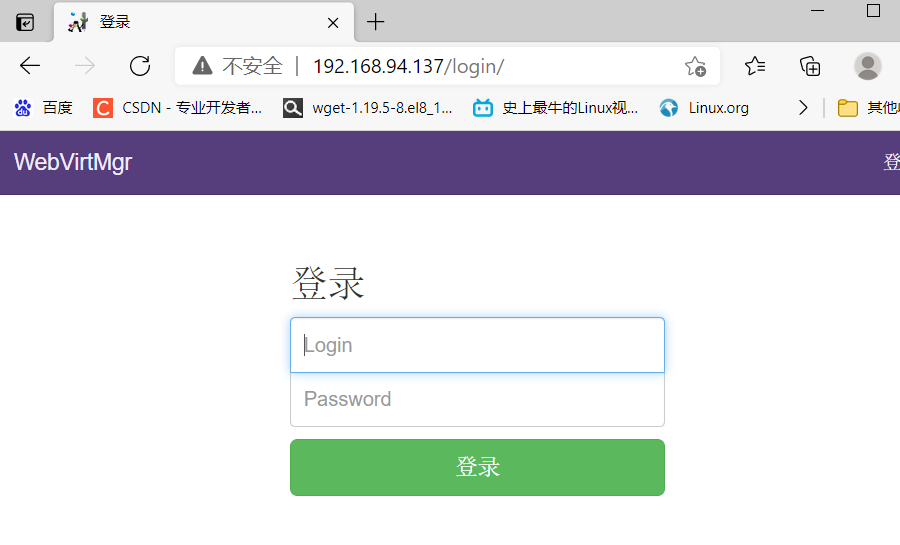


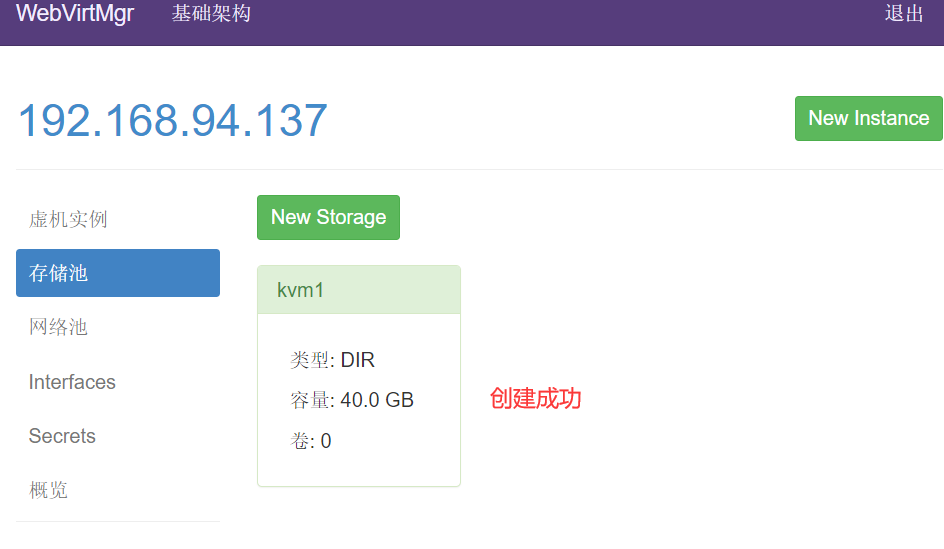
上传镜像到挂载目录
网络管理
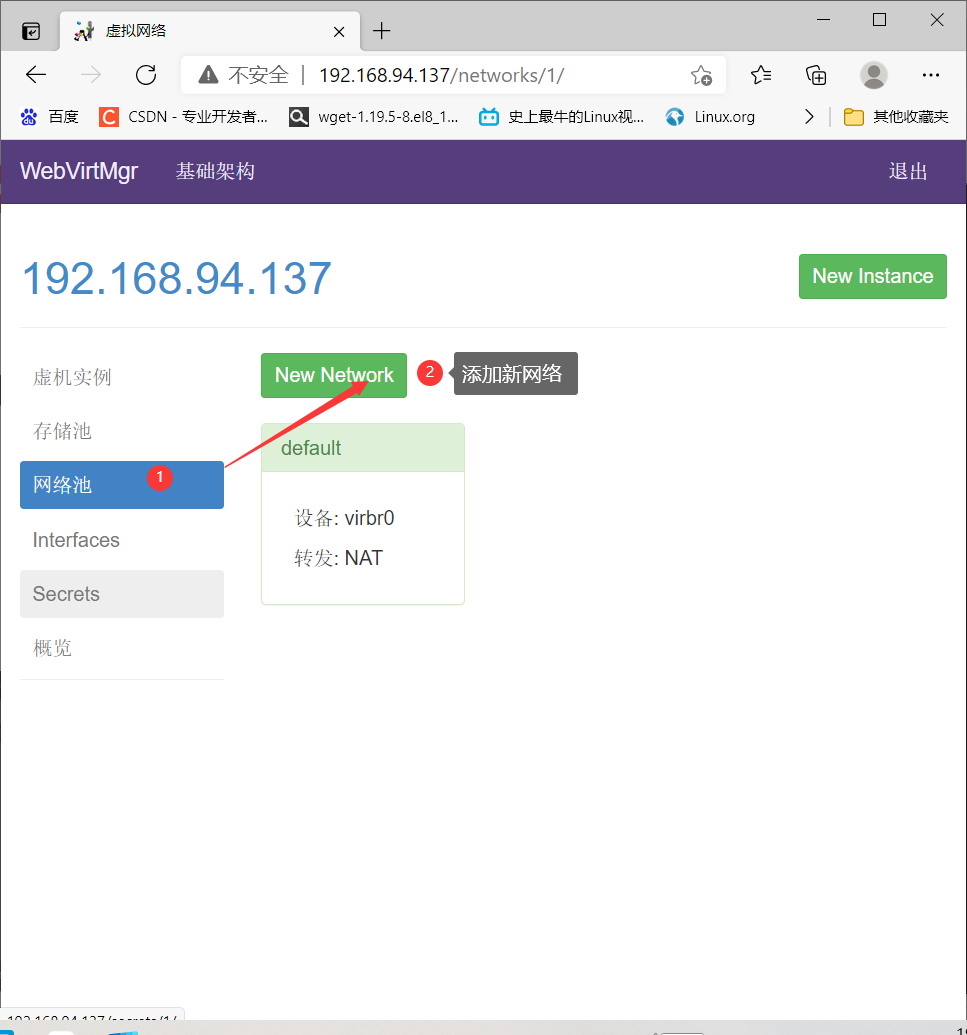
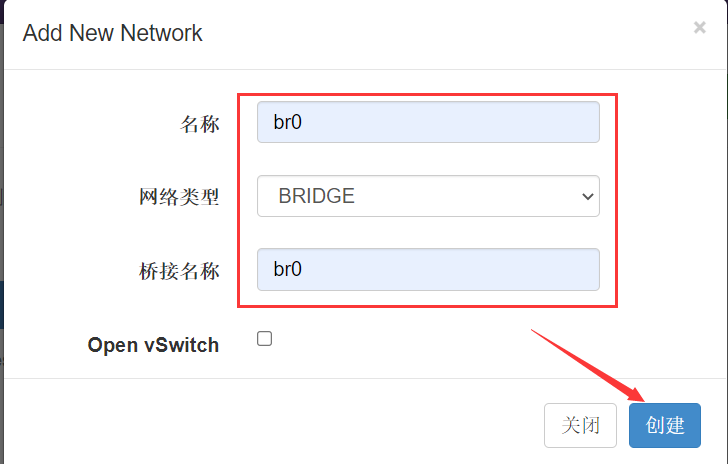
实例创建


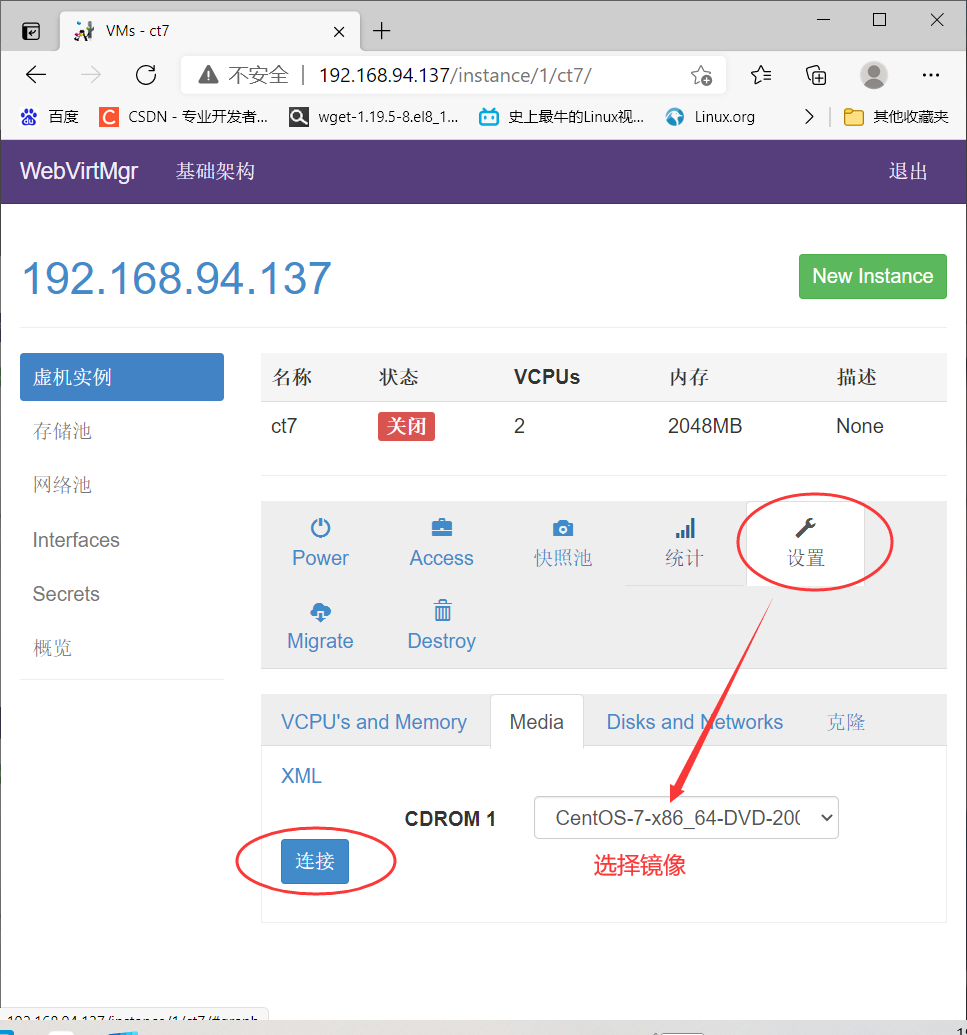
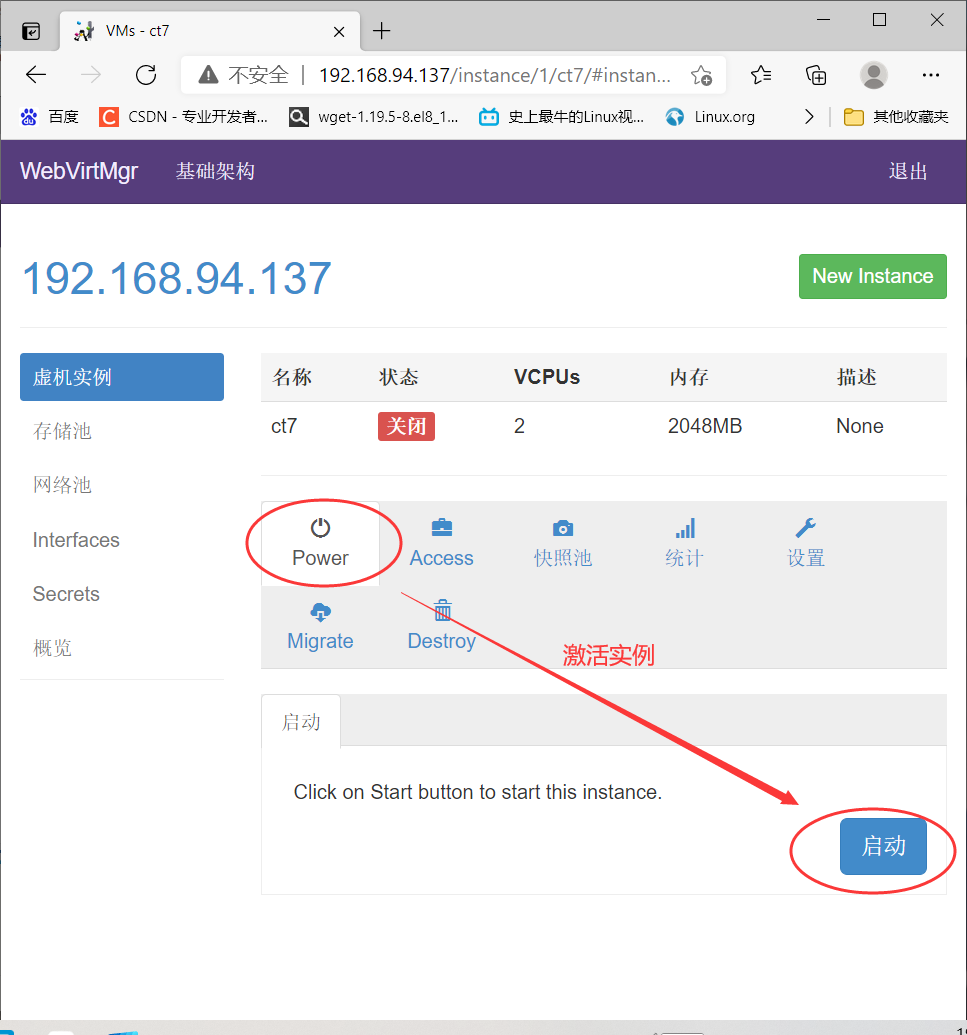
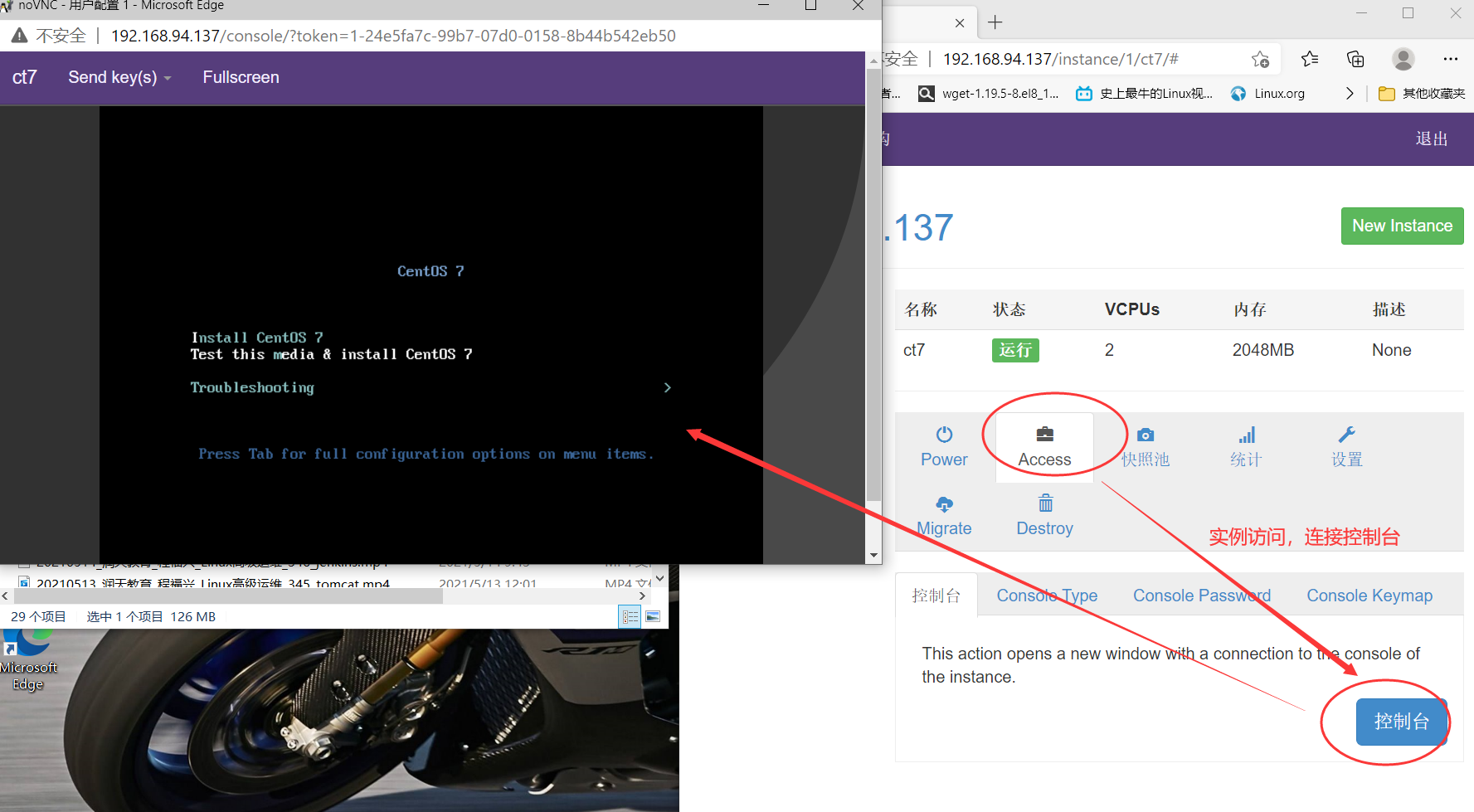
之后就跟VMware一样正常安装选项就行